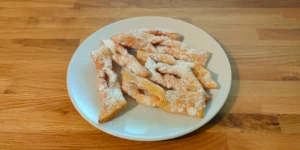
Faworki - chrust, chruściki, angel wings
Jump to recipe
Today we would like to share with you the recipe for one of the most beloved sweets in Poland - faworki. We can also find them under the name chrust, chruściki, kreple (it more refers to donuts but this name is also common) or simply angel wings. This name may vary depending on the region of Poland. The names mentioned are the most popular and state the same delicious sweets. Regardless of the name, they have the same wonderful, crispy interior and delicate taste.
Even though these cookies are fried in oil, they are very light and non-greasy. Sometimes, you have to be careful because they are so good that you would like to eat them one by one. These little, crunchy wonders bring back childhood memories and the taste of home warmth.
Faworki are popular not only in Poland, but also in other European countries, such as Germany, Lithuania, France and Italy. Each of these nations has its own variation of these crunchy treats.
The name faworki most likely comes from the French word 'faveur', which means a narrow silk ribbon. The Polish word 'chrust' means 'dry branches detached from trees' or 'a set of twigs'. 'Chruścik' is a diminutive of the word 'chrust'.
This specialty appears on tables on many occasions. From carnival to holidays such as Fat Thursday, Epiphany and Christmas Eve. Crispy and delicate in taste, faworki are an inseparable element of traditional Polish cuisine.
How were faworki created?
Faworki are cookies with a mysterious history. One of the older mentions of them appeared in Stanisław Czerniecki's cookbook from 1682. Some sources say that their origins date back to the Middle Ages and even Roman times. But is it true? Although there are similar regulations, is the common pedigree true?
Some sources say that they were brought to Poland in the Middle Ages from Germany or Lithuania. The fact that they are recognizable in many European countries may confirm the thesis of their common origin.
One legend even mentions a young confectioner who accidentally dropped a strip of dough into the oil. The strip formed a braid, and the confectioner sprinkled the product with sugar, which gave a new delicacy. But, it sounds like a typical tourist story :)
Although the exact origin of faworki is unknown, they have been part of Polish cuisine for centuries. Regardless of how they were created, they are worth trying.
How to prepare faworki?
Preparing faworki is not as difficult as it may seem. There are a few key rules that are worth knowing to achieve perfect results. Firstly, the ingredients must be carefully balanced and the dough carefully kneaded. The key to success is also properly hot oil in which the faworki will be fried - not too hot and not too cold. It is worth choosing high-quality vegetable oil to make the faworki crispy and tasty.
Traditionally, faworki are sprinkled with powdered sugar. But it is worth experimenting with toppings and sprinkles, e.g. adding chocolate, coconut flakes or nuts. For a more interesting taste, you can add some orange peel, vanilla or lemon to the dough. This is a perfect way to give faworki a unique aroma.
Recipe informations:
Ingredients
- 400 g of flour
- 150 g of sour cream 18%
- 4 yolks of eggs
- spoon of butter
- teaspoon of powdered sugar
- a spoonful of spirits
- pinch of salt
- oil for frying (deep frying)
